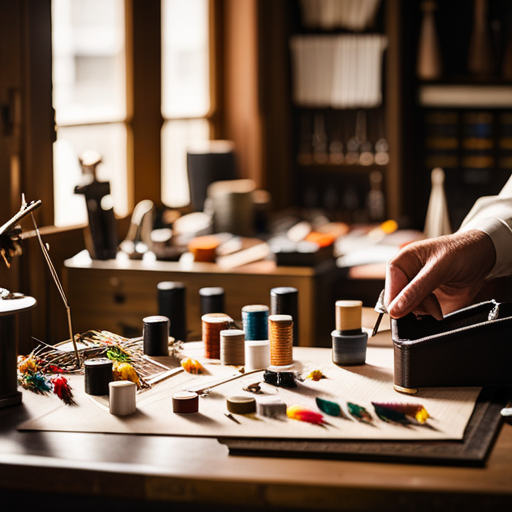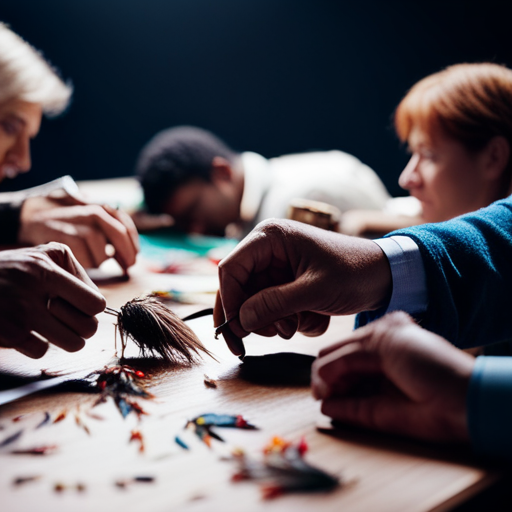Step into the world of fly tying, where vibrant feathers, intricate threads, and delicate hooks come together to create an art form steeped in history and culture.
From the traditional patterns of the Western world to the innovative techniques of the East, the diversity in fly tying is a celebration of creativity and craftsmanship.
Join us as we explore the global influences, unique patterns, and collaborative spirit that make fly tying a truly captivating and enriching pursuit.
History of Fly Tying
When did the practice of fly tying first emerge as a distinct craft within the angling community?
The ancient origins of fly tying date back to Macedonia in the 2nd century AD, where the craft was used to create artificial flies for fishing.
Over time, the evolution of materials and techniques has transformed fly tying into a sophisticated and artistic endeavor.
Early fly tiers utilized natural materials such as feathers, fur, and thread to construct flies that mimicked insects and small creatures.
As trade routes expanded, materials like silk and tinsel were incorporated, adding variety to the flies produced.
However, it was not until the 19th century that the craft truly gained recognition as an art form, with the development of new tools and the standardization of patterns.
This era saw the emergence of famous fly tiers who contributed to the refinement and popularization of fly tying.
The history of fly tying serves as a testament to the ingenuity and creativity of anglers throughout the ages, setting the stage for the exploration of various techniques and tools in the next section.
Techniques and Tools
The practice of fly tying involves the skilled use of specialized tools and techniques to create artificial flies for fishing.
Modern innovations have significantly impacted the tools used in fly tying. Traditional methods have evolved, giving rise to a wide array of specialized tools designed to enhance precision and efficiency. For instance, modern vises offer improved rotation and adjustability, allowing for intricate thread work and material placement. Furthermore, advancements in materials have led to the development of synthetic threads, feathers, and fur substitutes, expanding the possibilities for creating lifelike imitations of natural prey.
However, despite these modern innovations, many fly tyers still value and employ traditional methods, such as hand-tying intricate patterns without the aid of modern machinery.
Tool evolution has been complemented by a focus on technique mastery. This involves not only understanding the mechanics of using specialized tools but also honing the art of manipulating materials to achieve desired fly characteristics. From precise thread wraps to delicate feather manipulation, technique mastery is essential for creating flies that effectively mimic natural insects.
Ultimately, the combination of modern innovations and a dedication to traditional methods has enriched the craft of fly tying, allowing for a diverse range of approaches and styles.
Global Influences
The art of fly tying is a reflection of the rich diversity of cultures and traditions across the globe. As fly patterns are often influenced by the natural environment and local prey species, different regions have developed their own unique patterns and tying techniques.
Exploring these cultural fly patterns and international tying techniques can provide a deeper understanding of the global impact on this timeless art form.
Cultural Fly Patterns
Drawing inspiration from a multitude of cultural traditions, fly tying has evolved to incorporate diverse global influences in the creation of unique and captivating patterns. Traditional techniques and cultural significance play a crucial role in shaping these cultural fly patterns, each reflecting the heritage and practices of its place of origin. Below is a table showcasing a few examples of cultural fly patterns from around the world:
| Cultural Tradition | Fly Pattern |
|---|---|
| Japanese | Tenkara Kebari |
| Native American | Hopi Feather Fly |
| Scottish | Clan Chief |
These patterns not only showcase the artistry and creativity of fly tying but also serve as a testament to the rich cultural tapestry from which they originate.
International Tying Techniques
How do international tying techniques draw from a diverse range of global influences to enhance the artistry and creativity of fly patterns?
Traditional methods from various cultures, such as Japanese tenkara and Scottish loch-style fly tying, have contributed to the rich tapestry of international tying techniques. These traditional methods are characterized by their cultural significance and have had a global impact on modern innovations in fly tying.
For instance, the use of exotic materials and intricate weaving techniques from regions like Southeast Asia and South America has influenced contemporary fly patterns.
This fusion of traditional and modern approaches has not only diversified the art of fly tying but has also expanded the possibilities for creating innovative and effective fly patterns that cater to diverse fishing conditions around the world.
Diverse Fly Patterns
The diversity of fly patterns reflects unique cultural influences, environmental adaptations, and innovative use of materials. These patterns are not only a product of different regions and their distinct fly tying traditions, but also a testament to the creative ways in which fly tiers have adapted to diverse fishing environments.
Exploring these diverse patterns provides valuable insights into the rich tapestry of techniques and materials utilized in the art of fly tying.
Unique Cultural Influences
Cultural influences from around the world have led to the creation of diverse and unique fly patterns. These patterns reflect the rich tapestry of cultural traditions and artistic expression, resulting in a beautiful fusion of creativity and functionality.
When exploring the unique cultural influences found in fly tying, one encounters a world of mesmerizing patterns that evoke a deep sense of appreciation and wonder:
-
Japanese Tenkara Flies: Delicate and minimalist, these flies reflect the Zen philosophy of simplicity and harmony with nature.
-
Norwegian Salmon Flies: Intricately designed with vibrant colors, these flies showcase the folk art traditions of Norway, adding a touch of elegance to the craft.
-
Native American Feathered Flies: Symbolizing respect for the natural world, these flies honor the deep connection between indigenous cultures and the environment.
-
Australian Saltwater Flies: Reflecting the vibrant coastal landscapes, these flies capture the spirit of adventure and exploration, resonating with the thrill of saltwater fly fishing.
Environmental Adaptation and Impact
Adaptation to varying environmental conditions significantly influences the diversity of fly patterns utilized in fly tying practices. Fly patterns are intricately designed to mimic the behavior and appearance of natural prey in specific environments, leading to a wide array of patterns tailored to different conditions. Anglers and fly tyers employ various adaptation techniques to address the environmental impact on fly patterns, ensuring effectiveness in diverse settings. Environmental impact analysis further guides the development of new patterns, considering factors such as water clarity, temperature, and the presence of specific insect species. This deliberate approach results in a rich tapestry of fly patterns, each uniquely suited to its intended environment.
| Adaptation Techniques | Environmental Impact Analysis | Fly Pattern Development |
|---|---|---|
| Mimicking natural prey behavior | Considering water clarity | Researching insect species |
| Adjusting fly size and weight | Evaluating water temperature | Experimenting with materials |
| Varying color and silhouette | Observing insect activity | Testing in different environments |
Innovation in Materials
Invariably, the innovative utilization of materials in fly tying has resulted in an expansive array of diverse fly patterns, reflecting the precision and creativity essential to this craft.
-
Sustainable materials and creative techniques have opened up new possibilities, allowing fly tyers to create patterns with a reduced environmental impact.
-
Cultural inspiration combined with modern materials has led to the development of diverse fly patterns that pay homage to traditions while embracing contemporary innovation.
-
The use of unconventional materials has sparked creativity and ingenuity, leading to the creation of unique and visually stunning fly patterns.
-
Experimentation with materials has given rise to fly patterns that exhibit a harmonious blend of functionality and aesthetic appeal, captivating both fly tyers and anglers alike.
This constant evolution in materials and techniques contributes to the rich tapestry of fly tying, fostering a sense of community and collaboration among enthusiasts.
Community and Collaboration
Fly tying enthusiasts around the world have formed a tight-knit community dedicated to sharing knowledge and collaborating on innovative techniques. This community support has been instrumental in the development of collaborative projects that have advanced the art and science of fly tying. Through online forums, social media groups, and in-person gatherings, fly tyers are able to share their expertise, provide guidance to novices, and exchange ideas for new patterns and tying methods. Collaborative projects, such as fly pattern swaps and joint initiatives to develop new materials, have flourished within this community, fostering an environment of creativity and mutual learning.
One of the most remarkable aspects of the fly tying community is its collective willingness to share information and welcome newcomers. This inclusivity has allowed for a rich exchange of ideas, with experienced tyers mentoring beginners and newcomers bringing fresh perspectives to the craft. Furthermore, collaborative projects have led to the creation of innovative fly patterns and tying techniques that have enriched the overall fly tying experience.
The spirit of collaboration within the fly tying community continues to drive the evolution of this timeless art form.
Fly Tying for Conservation
The commitment to community collaboration in fly tying has extended to the realm of conservation efforts, where practitioners have harnessed their expertise to support and promote environmentally sustainable practices. This has led to the emergence of fly tying for conservation, where the focus is on utilizing sustainable materials and traditional methods to contribute to conservation initiatives and cultural preservation.
Fly Tying for Conservation: A Powerful Impact
-
Preserving Habitats: By creating flies that mimic local insect species, fly tiers contribute to the preservation of natural habitats and ecosystems.
-
Reducing Environmental Impact: Through the use of sustainable materials and traditional methods, fly tiers minimize their environmental footprint, promoting conservation efforts.
-
Cultural Heritage: Fly tying for conservation helps in preserving traditional fly tying methods, which are often deeply rooted in the cultural heritage of different regions.
-
Educational Outreach: Conservation-focused fly tying workshops and events provide an opportunity to educate and engage the community in environmental stewardship and conservation practices.
Frequently Asked Questions
How Can Fly Tying Be Used as a Form of Self-Expression?
Fly tying provides artistic expression through creative freedom. It allows individuals to showcase their unique styles, preferences, and personalities. Through the selection of materials, colors, and patterns, fly tying becomes a form of self-expression.
What Role Does Cultural Diversity Play in the World of Fly Tying?
Cultural diversity plays a significant role in the world of fly tying, fostering cultural exchange and global collaboration. Different traditions and techniques from diverse cultures enrich the craft, creating a vibrant and inclusive community.
Are There Any Traditional or Indigenous Fly Tying Techniques That Are Not Widely Known?
Traditional techniques and indigenous methods in fly tying are often overlooked. Many lesser-known fly tying techniques have been passed down through generations in various cultures, contributing to the rich diversity of fly tying practices worldwide.
How Can Fly Tying Be Used to Promote Environmental Awareness and Conservation Efforts?
Fly tying serves as a powerful tool to promote sustainability and engage communities in environmental awareness and conservation efforts. By incorporating eco-friendly materials and organizing educational workshops, fly tying encourages a deeper appreciation for nature and the importance of conservation.
What Are Some Unique and Unexpected Materials That Can Be Used in Fly Tying?
Unusual materials and creative techniques are expanding the possibilities in fly tying. Unconventional sources like recycled plastics and innovative patterns using unconventional materials such as hair, feathers, and even paper are redefining the art.
Conclusion
In conclusion, the history of fly tying spans centuries, with techniques and tools evolving to create diverse fly patterns influenced by global traditions.
The community and collaboration within fly tying fosters a sense of inclusivity and shared knowledge.
As fly tyers continue to celebrate diversity in their craft, they also contribute to conservation efforts through the promotion of sustainable practices.
The art of fly tying continues to thrive as a testament to the rich and varied traditions that inspire it.




